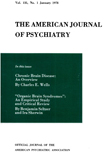EEG ABNORMALITIES IN EARLY CHILDHOOD SCHIZOPHRENIA : A DOUBLE-BLIND STUDY OF PSYCHIATRICALLY DISTURBED AND NORMAL CHILDREN DURING PROMAZINE SEDATION
Abstract
EEG tracings during promazine sedation were obtained on 58 children who had autistic or symbiotic childhood psychosis. For comparison EEG's were done under identical conditions on 4 other groups of children: 44 with chronic undifferentiated schizophrenia; 37 non-psychotic children with severe, acting-out behavior disorders; 10 with neuroses; and 13 psychiatrically normal children. Final clinical diagnoses were made without knowledge of the EEG readings as determined for this study, and the EEG's were all placed in random order and read without any knowledge of the clinical diagnosis. EEG abnormalities accepted were focal slowing, focal spikes, paroxysmal spikes and waves, and paroxysmal spikes and waves with independent spikes.
Among the 149 patients 51% had abnormal records. None of the psychiatrically normal children had EEG abnormalities. Except for the neurotics, the EEG abnormalities were qualitatively and quantitatively similar in the psychiatric patients. The most frequent abnormalities were irregular paroxysmal spike and wave complexes, often best seen during the transition from wake to sleep. Of the 149 patients, 33% had this complex, either alone or with independent spikes. Although these complexes were most frequent in the autistic-symbiotic group, the incidence was not statistically significantly different from the higher performing, chronic undifferentiated schizophrenics who had communicative speech or the non-psychotic children with acting-out behavior disorders.
Of the 58 autistic-symbiotic children, 19% had seizures, which is similar to the 13% seizure incidence in the remaining 91 psychiatric patients.
Whether the cerebral dysfunction implied by this study is a primary disorder or is secondary to some factor such as the effect of prolonged anxiety on body chemistry cannot be decided at this time. Nevertheless, an organic concomitant has been demonstrated in 51% of the psychiatrically disturbed children. By increasing the amount of time included in the EEG sample, the incidence of electrical abnormalities might be even higher.
Access content
To read the fulltext, please use one of the options below to sign in or purchase access.- Personal login
- Institutional Login
- Sign in via OpenAthens
- Register for access
-
Please login/register if you wish to pair your device and check access availability.
Not a subscriber?
PsychiatryOnline subscription options offer access to the DSM-5 library, books, journals, CME, and patient resources. This all-in-one virtual library provides psychiatrists and mental health professionals with key resources for diagnosis, treatment, research, and professional development.
Need more help? PsychiatryOnline Customer Service may be reached by emailing [email protected] or by calling 800-368-5777 (in the U.S.) or 703-907-7322 (outside the U.S.).



